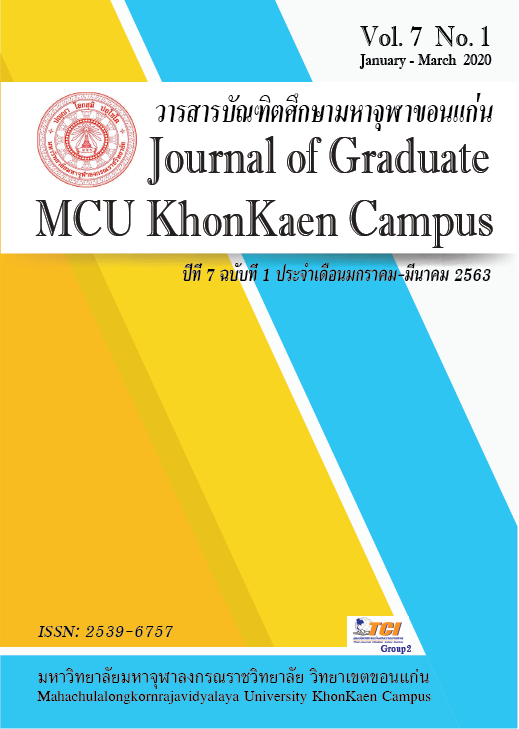BUDDHIST ETHICS IN THE MURAL OF BODHI SAN PAVILION 72 WAT PHO BAN NON THAN NAI MUEANG SUBDISTRICT MUEANG DISTRICT KHONKAEN PROVINCE
Main Article Content
Abstract
This research has 3 objectives which are 1) to study concepts 2) to study the history of murals at SalaPhotisan72, Wat Pho, Ban Than Than, NaiMueangSubdistrict, Mueang District, KhonKaen Province, and 3) to study Buddhist ethics in murals.Wat Pho, Ban Non Than, NaiMueangSubdistrict, Mueang District, KhonKaen Province Is a qualitative research The research instruments were interview forms. Key informants include 3 artists, 3 Buddhist scholars, 3 scholars, 3 villagers, a total of 12 people, analyzed by descriptive method
The result of the research shows that the Buddhist theories of ethics include principles of conduct or practices to enable people to live their lives to the ultimate goal in Buddhism, divided into 3 levels, namely the first level, the precepts of the body, the middle level of the speech, namely the level of merit-making. Mak8
Wall painting activity at Wat Pho Drawn for use in teaching Buddhists about the way of life of the Isan people along with interpolation of Buddhism. And is a teaching of living principles in accordance with Buddhist philosophy
Buddhist ethics as shown in the mural paintings of Wat Pho At the beginning level are The picture of should be afraid to return, pictures of rogue like Kongval, pictures of eating rice to plant on PhalanHin, the picture wants to have a precept to kill the father hit mother Middle level include The picture is peeling coconut, bite the mouth, the picture does not stop, is not a Buddha High level including The image wants to fall but is light, the picture wants to be colorful.
Article Details
References
PenkaeBuapa, 2010. Comparative study. Buddhism principles in Knan Zen sect and the Dharma puzzle in the 72 Bodhi San Pavilion, Wat Pho, Ban Non Than, Mueang District, KhonKaen Province. " Doctor of Thesis. Graduate school Mahachulalongkornrajavidyalaya University.
SanohThianthong. (2000). "An Analytical Study of Buddhist Doctrine Existed in Buddhist Art: A Case Study of PhrakhruUphaiPhadaporn (LuangPhorKhom), WatPhaiRongWua, SuphanBuri Province "Master ofThesis in Buddhism. Graduate schoolMahachulalongkornrajavidyalaya University.
NatthaphonSotthiratwiroj (2014). "Ethics of development: a survey of the development debate". Journal of Panyapiwat, Vol. 5, Issue 2, January-June 2014: 275.
Office of the National Economic and Social Development Board (2016) National Economic and Social Development Plan No. 12, Office of the National Economic and Social Development Board.
AmpornPhawasuth. (2017). "Professional Ethics and Buddhist Ethics", Veridian
E-Journal, Silpakorn University, Thai edition, Humanities, Social
Sciences and Arts, Year 10, Issue 3, September - December.

